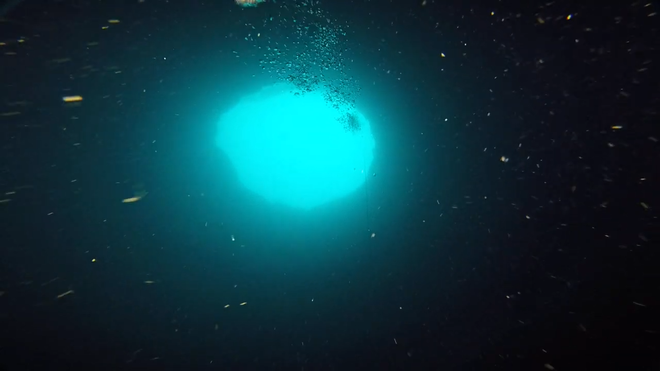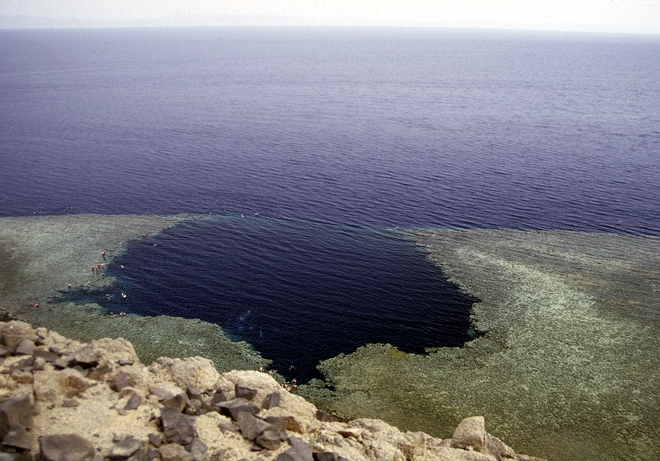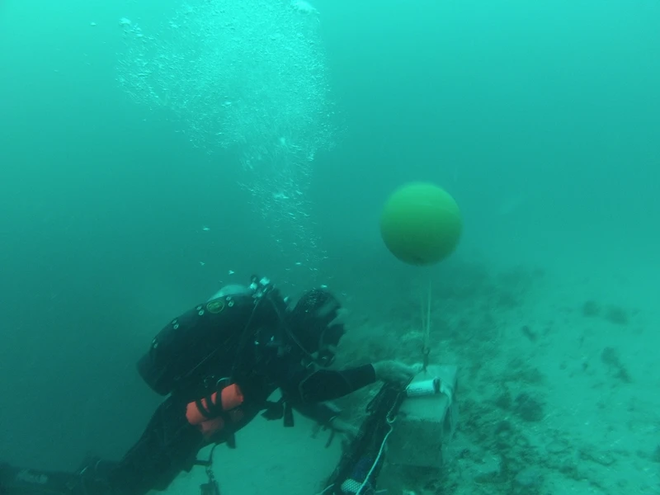Scientists conducted research on “green holes” on the ocean floor, discovering many interesting things
- Tram Ho
US scientists are preparing gear to dive into the “green hole” – a sinkhole located on the sea floor off the coast of Florida. The mysterious pit, called “Green Banana”, and promises to be the path to a treasure trove of knowledge lurking in the rift beneath the sea floor, such as the creatures living here as well as the The relationship between them and the aquifers . This project is an attempt to explore the second “deep ocean”, after the Amberjack expedition in 2019.

Amberjack pit is viewed from below.
” This will be the first time we have described the Green Banana hole, and eagerly compare it, both biologically and chemically, with the Amberjack pit ,” said Emily Hall, a member of the expedition team.
“ [Green Banana] has a different and deeper shape, so I’m not sure what we’ll find. This is one of the great feelings that discovery has… everything is new and makes us excited! ”.
Blue holes appear in many parts of the world, and can reach a depth of 300 meters, equivalent to the Dragon Hole in the East Sea – one of the deepest green holes in the world that researchers have ever discovered. Needless to say, diving into such depths is extremely dangerous; In fact, the Red Sea Blue Hole in Egypt is one of the scariest dive sites in the world.

Blue hole in the Red Sea.
However, green holes also contain their own secret secrets. It can be home to corals, molluscs, sea turtles or even sharks. They are the source of life nurturing the surrounding ecosystems, and scientists named the “oasis” in the middle of the vast sea.
“ We believe that they are hot water holes and sinkholes formed 8,000 years ago, when Florida was much larger than today. The pits we studied have many differences, both chemically and biologically, ”said Hall, and that much remains unknown about the origin and history of the pits. deep green and the underground cave system below.
Amberjack hole in the previous discovery was located off the Gulf of Mexico, the team conducted the survey during May and September last year. They dived 30 meters deep to reach the mouth of the hole 72 meters deep.

Amberjack pit exploration process.
Jim Culter, a member of the expedition team and senior scientist at Mote Marine Laboratory, described the trip into Amberjack as “a contrast to extremes”. “ The surface water is very warm, about 29.5 degrees Celsius and especially during a summer day. When you go deep, the water starts to cool down and thermocline phenomenon – the water temperature changes abruptly at a depth of 20-27m and the distance of vision starts to decrease ”.
” The crater is where many fish, turtles, crustaceans, corals and sponges are taking place, ” Culter continued . A little past the edge of the pit and into the cold water, the light began to weaken. When reaching a depth of 40-45 meters, another thermocline took place and the temperature dropped to 15 degrees C “.
At this depth, large marine species such as corals and fish no longer appear, but instead are colonies of bacteria and clusters of “rotten eggs” that smell like hydrogen sulfide. “The bottom of the pit is soft, muddy, very easily stirred by outside influences. Everything is dark until you look up and see the crater, covering the blue sea 45 meters from where you stand . ”
The bottom of the Amberjack pit is a thick layer of mud.
Ms. Hall swam around the crater because the training rules only allowed her to reach a depth of 60 meters. Despite this, Hall also witnessed firsthand the biodiversity at the crater. “ A series of questions ran across my head… What’s down there? Where does it lead to? Can I dive deeper? Most of the time I have to work, like collecting water samples and thinking quietly, counting the number of existing species, but sometimes I can also enjoy looking at the miraculous seabed! ”.
Besides the species living in the “oasis”, the expedition team also found two intact corpses of rare pointed saber-toothed fish. They took the male body 3.6 meters long to the lab to study.
Sharp-edged swordfish at the bottom of Amberjack blue hole.
These marine life graveyards are often accepted as “sacrifices” descending from the water above, but this is not just death: scientists have discovered nutrients flowing back from the Amberjack Pit, showing that this green hole provides organic matter that nurtures the surrounding ecosystems.
” We found that the holes have a higher concentration of nutrients than the surrounding water ,” Ms. Hall said. ” The exact source of these nutrients is unknown, but they may come from activities in the sedimentary layer below, or the effects of ocean currents flowing in underground caves .”
The team wants to apply the knowledge gained in the Green Banana expedition to a depth of 45 meters, with a bottom as deep as 129.5 meters from the crater. Nobody knows who gave the pit the name “green banana”, Mr. Culter said that the locals called it that when they discovered green bananas hanging near the pit.
It is expected that the green hole exploration project will take place in August this year and in May next year, hoping to find more new species.
“ We are exploring the blue holes near the shore, only about 30km from the beach. In total, about 20 well-discovered holes are areas where we have visited or received reports from reliable sources . ”
The ocean is still big and mysterious outside, this is just one of the many places we can set foot on. The dream of exploring the seabed is still there, waiting for the technology to be modern enough to implement.
Refer to Vice
Source : Genk
